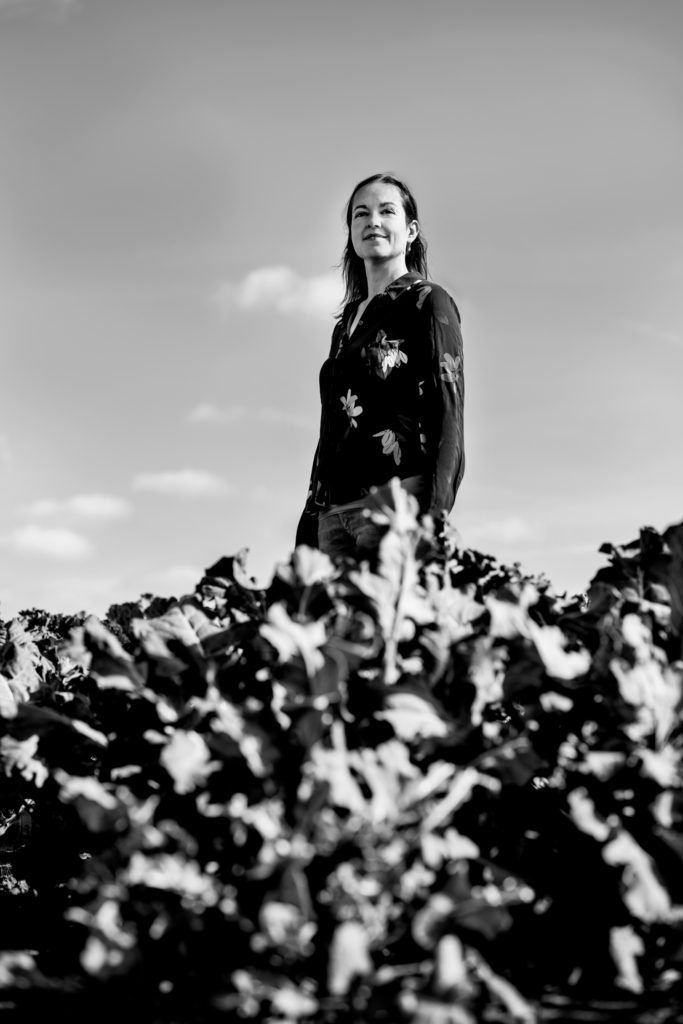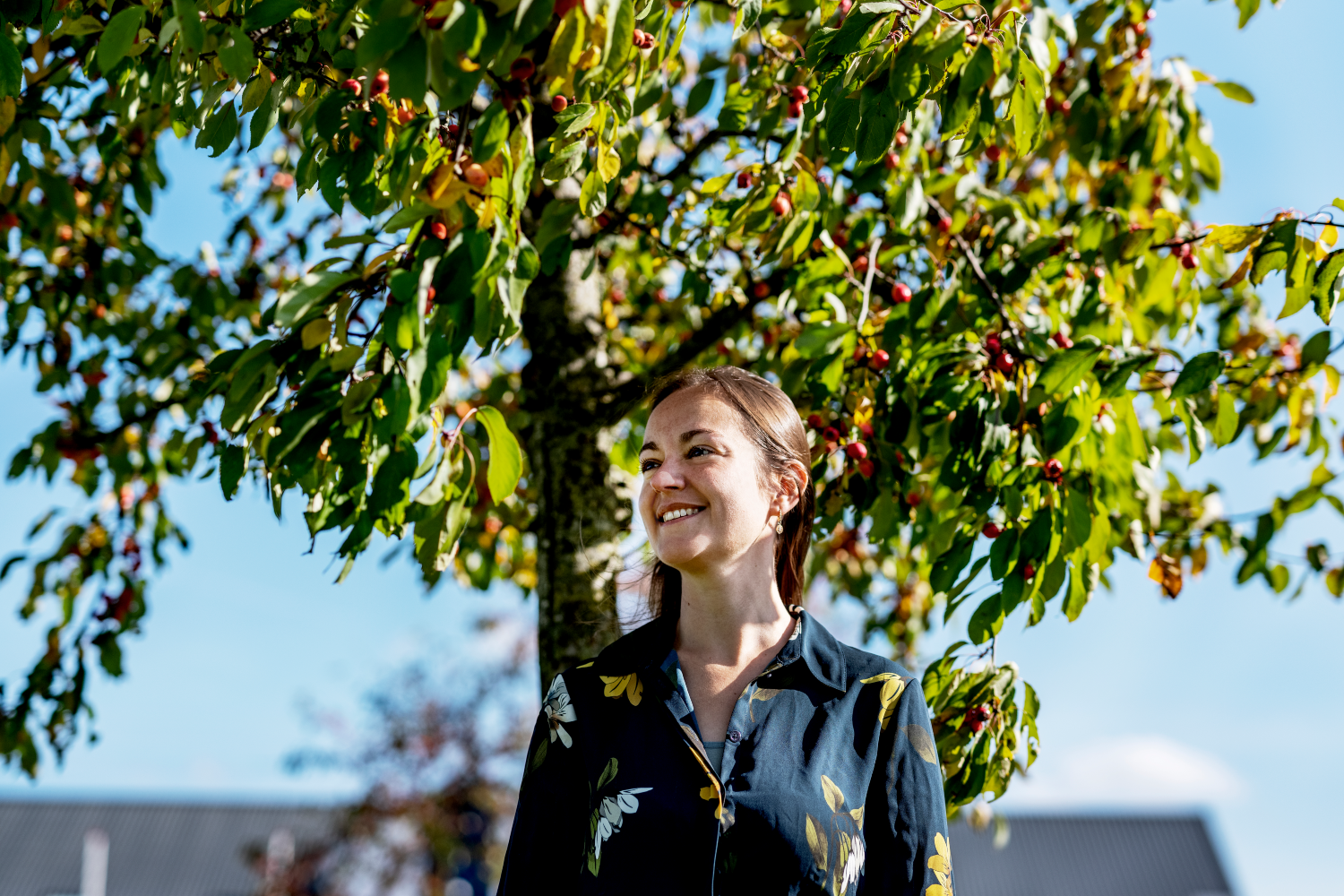Text Tanja Speek
Eating a little meat from livestock fed on leftovers from food supply chains is more sustainable than eating no meat at all, Hannah van Zanten has demonstrated. She is still working every day on perfecting the model for calculating this accurately. She herself has been eating an almost entirely vegan diet for a year now. ‘That’s the small step that I could still take to help reduce overall consumption of meat and dairy.’
Hannah van Zanten, associate professor in the Farming Systems Ecology chair group, was one of three science speakers at the opening of the academic year. As head of the Circular Food Systems research team, she explained how the European landscape and our diet will change if we shift to a fully circular food system.
Can you briefly explain what the essence of your story is?
‘Well, briefly? I can at least explain my research question briefly. I am analysing how we can feed the whole world healthily, while respecting the planet’s limits. What would we eat if we did that? The answer to that question, and how I arrive at it, can’t be explained so briefly, though. The key change involved is that our food system needs to become circular. That means we minimize the amount of food we give to livestock that we humans can eat ourselves. We feed livestock on waste streams from the food supply chains, such as wheat groats, a by-product of flour that makes excellent livestock feed.
We need to minimize the amount of food we give to livestock that we humans can eat ourselves
We will have to eat a lot less meat, a little less grain and potatoes and a lot more vegetables and legumes. So says the EAT Lancet diet, a description of a healthy and sustainable menu published by other researchers in 2019.’
Is the EAT Lancet diet circular?
‘No, the EAT Lancet diet is based on what the food system looks like now. But if you rearrange the system, everything changes with it. Especially if you make it circular. If you want to feed all chickens in a circular system, there won’t be enough waste products for other livestock. The total livestock population is going to have to shrink and the numbers of chickens, cows and pigs affect each other.
It is like a Rubik’s cube: if you change one part of the picture, the rest changes too. With my group, I have developed a mathematical model, the Circular Food Systems model (CiFoS), which incorporates all these dependencies. So you can calculate the effects of different choices regarding land use and food security. And then you can ask other questions about the food system of the future.
For example, for our health it is better to eat rather more chicken than beef. But in terms of land use, beef from dairy cows is actually very efficient. So there’s a conversation to be had about what our priorities are.’

Your career began with a completely different animal-related theme.
‘True. After finishing secondary school in Zutphen, I went to study Animal Management in Leeuwarden. I was always a real outdoor kid and I spent a lot of time around animals. I decided to go vegetarian when I was four. I was particularly interested in animal behaviour, so in the course of my degree I spent a year in Africa studying animals. I saw there how illegal hunting was driven by poverty and hunger. I wanted to get a fuller understanding of how our world works and the role of our food system in it. So I decided to take the Master’s degree in Animal Sciences at Wageningen. I chose the Animal Production Systems track, where researchers calculate things like the environmental impact of livestock farming.’
Did that feel like a big change?
‘The education in Wageningen was so different. It wasn’t about learning facts here, but about analysing complex issues. That gave me a lot of energy. I graduated cum laude. And then I went on to get my PhD cum laude. I surprised myself by doing that. At secondary school, I was more interested in being out of doors and my books usually stayed in my bike bag’.
You were already studying waste streams in your PhD research.
‘Yes, indeed. I wrote my proposal on one side of A4. My supervisors gave me a lot of freedom. It had to be about using waste streams for animal feed, that was all. And that turned out to suit me perfectly.
I started by calculating the environmental impact of feeding pigs with more by-products. But before long, I thought, I can calculate this for pig farming, but if such a system uses up all the by-products that are currently fed to cows, what use is it? I didn’t want to devote my entire PhD to that. So I decided to do the calculations for the whole livestock sector, linking everything together. What would be feasible in that case? It turned out that we would have to eat much less meat than we currently eat on average.
I surprised myself by getting my PhD cum laude
After my PhD came the questions that resulted in my VENI research. Suppose we all switch to a healthier diet, such as eating wholemeal bread instead of white bread. Then a massive waste stream disappears, and what is the effect of that? And I have many more questions. I would also like to look at the likely impact of a transition to strip farming, or what the economy needs to look like.’
Do you expect that we really will eat differently in the future?
‘Yes, and it’s got to happen. Fortunately, I see lots of initiatives. A company like Kipster, which I work with, now feeds their chickens entirely on waste streams, mainly bread scraps from large bakeries. And the trend towards more plant-based food is already evident. Just take a look in the supermarket. Two years ago you hardly saw any vegan products, but there is much more attention to that now. Another example is how fast the development of in vitro meat is moving. But we must look at the overall picture critically and keep a close eye on whether alternatives are genuinely sustainable and healthy.’
Have you never considered starting to eat a bit of meat again yourself?
‘No, in fact I’ve been eating almost exclusively vegan for a year now. That might seem like a contradiction, but I would like to see us all taking a step in the right direction. A big meat eater could at least go without meat one day a week. And the step that was still possible for me was to give up dairy products. That way I can compensate for the meat and dairy that someone else finds too hard to do without. To me, that seems a much more useful approach than judging each other. Besides, as long as we’re faced with infectious animal diseases and animal welfare issues, I’m very happy to eat vegan.
Another reason for me to do it was just to see what it is like to take such a step. I used to love eating cheese, on a sandwich or in a lasagne. For a while, I found it very hard to give that up, especially when I went into the canteen and smelled and saw those delicious things. But that ebbs away after a few months. Now I don’t miss it anymore.’
Do you actively engage in the debate?
‘The debate is often tricky, it revolves around extremes, and we forget to look at each other and really listen. I would much rather look at what the other person needs in order to change. I don’t think in black and white terms, but look for solutions. I want to understand the mechanisms at work, and then you see that it is actually quite logical that the sector has become the way it is.
Where I am active is in organizing meetings for stakeholders, giving lots of lectures, and making videos or infographics about our research. Because helping to get that ball of change rolling is very important to me.’
Hannah van Zanten (1983)
Born in: Rotterdam
Lives in: Wageningen
Education: Animal Management in Leeuwarden; Animal Sciences in Wageningen
Job: Associate professor at Farming Systems Ecology
Research: Circular Food Systems model (CiFoS), a computer model for calculating options in land use and food security
Plus: Collaboration with Kipster to develop the Netherlands’ first climate-neutral laying hen farm with a circular food system

 Photo Duncan de Fey
Photo Duncan de Fey